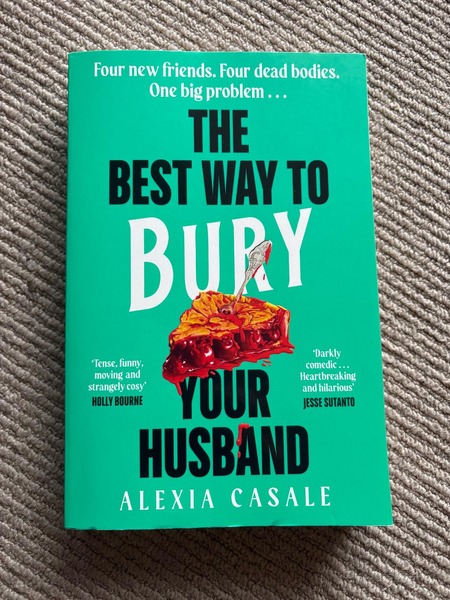Comedy, if you’re not paying attention, might look for all the world like a rip-roaring fun fair of ephemerally hilarious nothing, there one amusing minute and gone the more soberly serious next.
But in the hands of someone who truly knows what they’re doing, a richly comedic story can wield a whole life of pain and hurt and meaning and leaving you grinning at the absurdity of it all but deeply affected by the incisive emotional heft hidden within its seemingly soft and funny surfaces.
Someone who absolutely knows what they’re doing in the spoonful of sugar department is Alexia Casale whose debut novel, The Best Way to Bury Your Husband, seems to promise, by its quirky title alone, a riotously light and bright excursion into some sort of exploration of what can happen when marriage goes murderously wrong.
And to an extent, that’s true.
But such is the brilliance, sensitivity and empathetic cleverness of Casale’s writing that while there is indeed a surfeit of marriage ending in death and highly justifiable violence, that you walk away from this novel with far, far more than just an amused grin on your face.
In fact, this story of four ordinary women who have endured many years of horrific domestic violence before they, often without realising what they’re doing, do something about it, ends up moving you quite deeply to the point where you ache for the terror visited upon the, weep at the horrors they were handed instead of a life filled with love and contentment, and tremble at the nightmarish cruelty of men who think of nothing of wielding words, and more, as weapons.
Like everyone else, I’d [Sally] read stories in the papers about women who’d fought back, but I couldn’t begin to understand these women. For years they seemed like a different species. I used to wonder it it was a type of desperation I’d yet to experience, or some inner store of strength and courage — and, if so, where I could get some.
Then I went and smashed Jim’s head in with Granny’s skillet.
The Best Way to Bury Your Husband is the sort of book that you cannot put down.
It is not simply because the events it encompasses are immersively compelling in ways it’s almost impossible to articulate; but because Casale has done a brilliant job at forming her characters and giving them life and words that sing even as they deeply affect and yes, amuse you, and making them the sort of people who spring alive from the pages in which they now reside with far more life and vivacity than they were ever allowed when their husbands were alive.
Getting to know Sally, who is the spearhead of a quite unusual club, the Lockdown Ladies’ Burial Club – The Best Way to Bury Your Husband is set during the height of the first 2020 COVID lockdowns in the UK which fuels many of the deftly executed contrivances of the plot – and Samira, Ruth and Janey (and those connected to them like Samira’s daughter Leila and Sally’ deceptively cranky neighbour Edwina) is a joy, even in the face of the searingly dark situation in which all four women find themselves.
Much of the driving momentum of the novel comes not from its narrative punctuation points, though they are absolutely compelling and wonderfully well told, but from the way in which four previously isolated women find a family with each other and a way out of the darkness in which they find themselves after they have rid themselves of the hell that preceded it.
(courtesy official author Goodreads)
The genius of The Best Way to Bury Your Husband is that it tackles a staggeringly great social evil and draws much-needed attention in the most readable of ways.
In a lengthy Author’s Note at the back of the novel, Casale sombrely notes that “a woman is killed by a man every three days in the UK: in the vast majority of cases, that man is a current or former partner.”
She goes on to disclose that at the start of the period of COVID lockdowns, this already horrifying rate doubled, her understanding of this dire issue the result of working as a human rights non-fiction editor for more than 12 years, with a particular focus on violence against women and girls.
The author points out that even in those rare instances where a woman kills her lomg-term partner, as happens on four separate occasions in The Best Way to Bury Your Husband (which Casale admits is highly unlikely but essential to drawing attention to the plight of these abused women), “the pattern of long-term abuse doesn’t reverse: Instead, it is still the woman who, in the majority of cases, has suffered long-term abuse”.
Reading the Author’s Note helps drive home a fact already starkly present in the novel that women driven to this kind of violence has suffered horrifically over many years until, quite understandably, they just snap.
Revisiting the past is a last thing I feel like doing, but if that’s what it takes to keep her happy while I deal with the local corpse infestation, it’s a small price to pay.
The question is, of course, what happens next, and while The Best Way to Bury Your Husband does some quite lovely things like giving four isolated women the close friendships denied them by their socially controlling husbands and the strength and power of unconditional interdependent to ensure the seemingly unedurable, it never stints on being brutally honest about what they have gone through up until the point of no return.
There are some quite confronting and chilling moments in the novel which will shake you to the core – you won’t be able to believe that one person could treat another with such sustained grievous, nightmarish cruelty.
It’s horrifying and deeply unsettling to read, but it does what it needs to do – it helps us to understand, even in a very small way, that domestic violence against women is not just the stuff of headlines and exposes and that here are real people, very real people, enduring that gives us chills down to the very core of our being, every single day.
It is their daily lived experience and Casale does a brilliantly empathetic and emotionally evocative job of helping us to understand what drives women to commit such acts and why this is often there only way out of intolerable situations (though, of course, helping them to escape these abusive lives ahead of any retributive act is far preferable and what many organisations devote themselves to doing on a daily basis).
The Best Way to Bury Your Husband is in many ways horrifying and alarming but then it needs to be to get its message across; what it also manages to do is tell the stories of four amazing women, and others in their circle with humour, grace and compassion and to help us to understand that there is hope in the even the darkest of circumstances and that what makes the difference is love, connection and the sense of found family that begin to heal some long held and quite terrible wounds.

